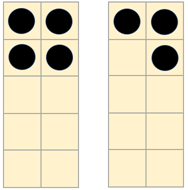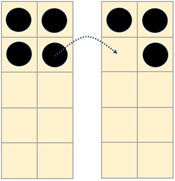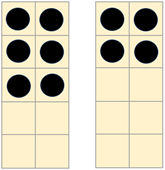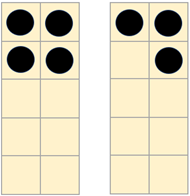The purpose of this activity is to support students learning their basic addition facts to ten.
- Counters (circular, square or novelty counters)
- Blank tens frames (use page 2 of Material Master 4-6)
- Begin with a number of counters less than ten (e.g. 7). Arrange the counters on two tens frames.

- Discuss the model and make connections to relevant mathematical language, symbols, and te reo Māori kupu.
How many counters are on each frame?
How many counters are there in total?
How can we record that information in an equation?
Tāpiri means to add. We have added whā and tōru to make whiitu.
Record 4 + 3 = 7
- Move one counter between frames to create 3 + 4 = 7.

- Discuss the model and make connections to relevant mathematical language, symbols, and te reo Māori kupu.
How many counters are on each frame?
How many counters are there in total?
How can we record that information in an equation?
Look at our two equations - what has changed and what has stayed the same?
3 + 4 = 7
4 + 3 = 7
Look for students to notice that the addends have changed position, but the sum is the same.
- Why is the sum still seven? (Moving counters from one frame to the other does not change the total number.)
Continue moving one counter from one frame to the other. As you move each counter, discuss the number of counters shown on each frame, and the sums created.
2 + 5 = 7
3 + 4 = 7
4 + 3 = 7
5 + 2 = 7
Emphases that moving counters from one frame to another creates a vertical pattern of addends for 7.
- As a class, read through the equations you have created.
Ask: What equations come next?
Students might add to the pattern above and below, e.g. 1 + 6 = 7 and 6 + 1 = 7, to identify subsequent equations. Provide time for students to explore this in pairs, using counters and blank tens frames as needed. Remember to include 0 + 7 = 7 and 7 + 0 = 7.
- Ask students to share the other tens facts they have come up with. Write these alongside your vertical pattern of addends for 7. As students provide you with facts, model them using counters and blank tens frames.
- Use an eraser to remove equations in the pattern while still expecting students to recall the facts.
0 + 7 = 7
3 + 4 = 7
6 + 1 = 7
Ask for sums that are and are not present.
What is five plus two? What is two plus five? (Students should know the sum is always seven)
Name an addition fact that equals seven.
- Provide students with lots of opportunities to practise and learn the facts for a given sum, and to express their mathematical thinking in different ways (e.g. online tasks, written, verbal, drawn diagrams, acting out, physical manipulatives, flash cards, games, online learning objects).
- Develop students’ fluency with facts to ten by working on a dedicated set of facts with the same sum for a few days. Important sums are six, seven, eight, nine and ten. Subitising experiences also support fact learning and retention.
How many counters do your see? (Flash the card then hide it)
How do you know there are ten dots?
Accept students’ approximate answers and provide connective feedback. For example, if a student says nine, show the frames to reflect their answer.
Six plus three equals nine (removing a counter to show 6 + 3 instead of 6 + 4).
Next steps
Patterning supports students to connect the addition facts which aids memory.
- Set up a trusted fact using tens frames, such as four plus three equals seven. Record the equation 4 + 3 = 7.

Ask facts that can be derived from 4 + 3 = 7. For example:
What is four plus four?
What is three plus three?
What is five plus three?
What is three plus two?
What is five plus four?
The answers students give can be confirmed by adding or subtracting counters from the frame model. As much as possible, move to working without visual support, relying on the symbols alone.
Provide lots of opportunity for practice and provide students with a way to monitor their progress in learning the facts.